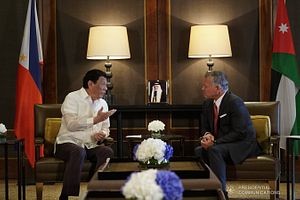One of the main outcomes of Philippine President Rodrigo Duterte’s visit to Jordan last week was the conclusion of a new defense agreement between the two countries. While it is still early days and specifics remain unclear, the pact nonetheless reflects the wider convergence between the two countries and signals where both nations plan to take the security side of their relationship in the years to come.
While the Philippines and Jordan have had a diplomatic relationship since 1976, ties have remained largely underdeveloped and often consumed by challenges such as the management of Philippine domestic workers in the Middle Eastern country. Within that context, the defense side of the relationship has remained below their potential, despite growing convergence on issues such as counterterrorism.
Duterte’s visit to Jordan – the first ever by a sitting Philippine president – presented an opportunity for both sides to advance the defense aspect of their ties still further. And one of the key items on the defense aspect of the visit was the conclusion of a memorandum of understanding (MOU) on defense cooperation between the Jordan Armed Forces-Arab Army and the Department of National Defense (DND) of the Philippines, with the agreement signed by DND Secretary Delfin Lorenzana and Joint Chiefs of Staff Chairman Lt. Gen. Mahmoud Freihat on Thursday during Duterte’s trip to Jordan.
According to the Presidential Communications Office, the agreement itself covers various aspects of defense collaboration, including defense and security policy; defense and military education training and capacity building; peacekeeping operations; humanitarian assistance and disaster relief; logistics and maintenance; armaments and military equipment; defense industry and technology; and research and development. The wide range of areas included, which mentions that other aspects could also be added by mutual agreement, paves the way for collaboration to proceed along several different lines in the coming years.
Few specifics were provided as to how both countries plan to operationalize the new agreement. But Duterte’s defense-related engagements during the visit, which included attending a counterterrorism-focused military drill at the King Abdullah Special Operations Training Center and a trip to the King Abdullah Development and Design Bureau – the country’s defense industrial arm – offered some insights into how the pact may be followed through on.
The media headlines were focused primarily on how both sides plan to advance the military equipment and capacity-building aspects in the defense pact. Headlines in this respect focused on the transfer of attack helicopters from Jordan to the Philippines, which is expected to occur around July next year (See: “What’s Behind the New Jordan-Philippines Helicopter Deal?“). Beyond that, Special Assistant to the President Christopher “Bong” Go also noted that other military equipment would be included, including mortars, rifles, and rocket-propelled grenades (RPGs).
There are indications of the possibility of more activity in this aspect of ties in the coming years as well. While Go did specify that no deals had been agreed to yet, he also did indicate that Manila may consider the possibility of buying other military equipment from Jordan and Israel.

































